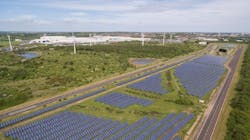Three of Nissan’s electric vehicle models will be assembled at an expanding United Kingdom plant which is going to be powered by a microgrid while adding new renewable energy resources.
The automaker announced that it is going to ramp up production of two additional EV models at the EV36Zero Hub in Sunderland, UK. The expansion will require a third battery gigafactory to support the facility and electric vehicle production.
The EV36Zero hub, involving more than 1 billion Euros of investment, also will be powered by a dedicated microgrid powered by wind and solar farms in place and planned for the near future at the Nissan complex. The zero-carbon resources will help electrify Nissan and surrounding suppliers, according to the Nissan release.
“The EV36Zero project puts our Sunderland plant, Britain’s biggest ever car factory, at the heart of our future vision,” Nissan president and CEO Makoto Uchida said in a statement. “It means our UK team will be designing, engineering and manufacturing the vehicles of the future, driving us toward an all-electric future for Nissan in Europe.”
Nissan’s EV line will include future versions of the Nissan Qashqai compact crossover, JUKE hatchback and LEAF compact models, the latter of which is one of the UK's most popular vehicles. All three are based on the company’s new all-electric concepts Hyper Urban, Hyper Punk and Chill-Out. More details on the three models will be released at a later time, Nissan reported.
The microgrid planned to power EV and battery production was first initiated by the Sunderland City Council. It will include Nissan’s new 20-MW solar farm, as well as existing nearby wind and solar projects.
The automaker first announced the expanded renewable energy plan for Sunderland in 2021. At the time, Nissan reported that the 37,000-panel extension would bring the on-site renewable energy portion to 20% of the assembly plant’s needs.
Nissan began adding on-site renewables in Sunderland 18 years ago with 10 wind turbines totaling 6.6 MW in capacity. In addition to current solar installments, the new 20-MW solar project would bring the plant’s renewable capacity to 32 MW, according to reports.
Electric vehicles and their batteries are possibly going to serve as mobile microgrids in the future. Other automakers, including Toyota, are exploring research into the bidirectional opportunities for EV microgrids contributing power back into the main grid or backing up homes or other facilities.








